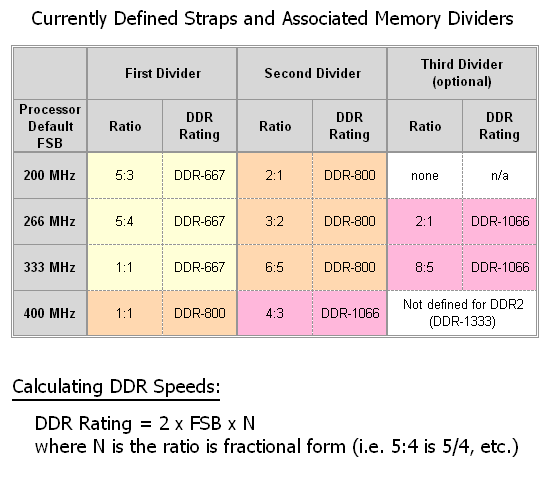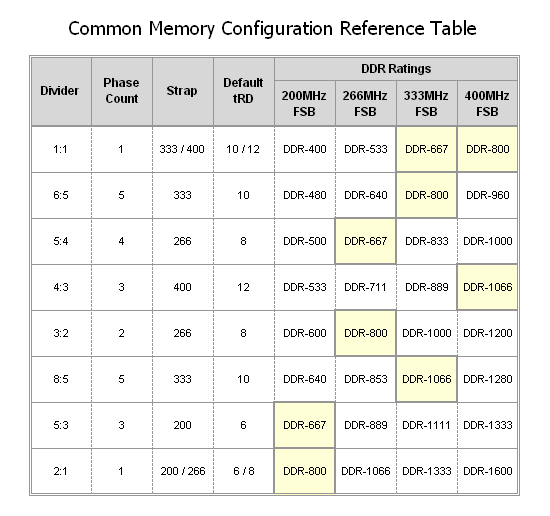ASUS ROG Rampage Formula: Why we were wrong about the Intel X48
by Kris Boughton on January 25, 2008 4:30 AM EST- Posted in
- Motherboards
The Basics of Strap Selections, Dividers and Derived Memory Speeds
We have discussed MCH Read Delay (tRD) and its effects on memory read performance before. About a year ago, this particular setting allowed some vendors to design boards that seemed to outperform competing companies' products consistently on a clock-for-clock basis. This was around the time that the enthusiast community first realized the importance of "straps". Some found that by setting a lower strap while running an equivalent Front Side Bus (FSB) that they were able to achieve better performance, higher frame rates, and better benchmark completion times all without the help of any additional tuning.
For those that are unfamiliar with what we mean by strap, consider the following example. Suppose you have two different CPUs, each with a different default FSB, as is the case with first-generation Core 2 processors (266MHz) and current 45nm Core 2 processors (333MHz). If you were to install these processors in identical systems each would be capable of running the same memory speeds (at least DDR2-667 and DDR2-800), regardless of the processor's default FSB. For the 266MHz default FSB processor, this would require a 5:4 and 3:2 divider respectively, while the 333MHz FSB variant would need 1:1 and 6:5. These ratios are necessary in order for the motherboard to set up allowable memory subsystem to system data bus interface configurations.

Because of this, the motherboard does not need to know anything about the installed processor and memory, other than the default FSB and the memory's SPD rating, which are both read programmatically prior to Power On Self Test (POST). For example, a 266 FSB processor paired with DDR2-800 memory will make use of the associated 266 strap's second divider - as would a 333 FSB processor. Would you be surprised to learn this works exactly the same way for a 200 FSB processor? Well, it does, and in fact it does not matter which processor type is installed - all combinations work and allow for the same exact memory speeds - DDR2-667 and DDR2-800 (and sometimes DDR2-1066).
If slower memory is detected the system simply uses the first divider in order to achieve DDR2-667 speeds. In the case of faster memory, the third divider is used for DDR2-1066 - which is sometimes available, depending on the strap in use. (All 266, 333, and the upcoming 400 MHz FSB parts will be able to make use of this new official memory speed, as recently announced by JEDEC.) One final note, "down" dividers are no longer possible with Intel platforms and as such the lowest supported memory speed for systems that will make use of the QX9770 (when it arrives) will be DDR2-800, unless the user chooses to underclock the FSB.
As we can see, this system allows for maximum component interchangeability and configuration flexibility all through the use of relatively straightforward selection logic. Check the table below for more information on how to derive these numbers.

Now that we know a little more about what straps are and how they work, we are ready to discuss what they mean when overclocking. Let's say you have an E6700 that makes use of a default FSB of 266MHz - pushing the FSB to 400 while making use of the processor's default strap's second divider (3:2) results in a final memory speed of DDR2-1200, a goal that might be outside the realm of normal achievement unless you have memory capable of this speed. By selecting the 400 strap the 1:1 and 4:3 dividers become available and we are able to set a more modest speed of either DDR2-800 or even DDR2-1066. Alternatively, choosing the 266 strap permits use of the 5:4 divider for DDR2-1000.
The point is that the freedom to choose any strap we want, regardless of CPU type installed, gives us the choice to make use of a whole myriad of memory speed settings that would otherwise be unavailable. Take note of the "Default tRD" column; you will see that each strap has an associated value (6 at the 200 strap, 8 for 266, etc.) We will discuss this particular setting in detail a little later.
Until now, choosing a memory divider in order to set a final memory speed was easy. Most users focus solely on achieving maximum CPU frequency, letting the memory speed fall where it will. Although it is possible for memory to be the limiting component when overclocking, this is unlikely considering the low cost and high availability of today's performance DDR2 modules. Thus it's easy to pick a memory divider that places the memory operating point near a maximum without ever considering what could be done in order to further improve performance.
Perhaps too many users feel the time they need to invest in fine-tuning their memory settings is not worth the effort. While this might not be far from the truth, we find this hard to believe. Major memory manufactures like OCZ, Corsair, Cell Shock, G.Skill, and Team Group have entire departments of support personnel that work hard every day to provide users the assistance they need to make the most of their purchase. These groups are inundated with requests for help, from both experienced users and novices alike.
Going back to what we said before, what does all of this have to do with better performance on a clock-for-clock basis? In a word: everything! We would like to provide some solid information on the subject as to why the age-old quest for maximum FSB is not always the best approach; in fact, it is often the wrong approach. Our hope is that once allowed an opportunity to make use of this information, users will begin to understand the true limitations of their system components better and might perhaps stop inappropriately blaming overclocking failures on perfectly good hardware. Better yet, they'll stop buying boards based solely on FSB capability when overall system performance is much more important.
Now that we have had a chance to review the basics on memory straps let's move on to something a little more interesting - MCH clock crossing operation and the associated MCH Read Delay (tRD).










73 Comments
View All Comments
poohbear - Friday, January 25, 2008 - link
one thing i liked about some of the recent high end mobo releases was the inclusion of an onboard wi-fi chip on a desktop mobo, but this mobo seems to be lacking that. i mean, they threw in everything but the kitchen sink, why not include wi-fi?:(TheDoc9 - Friday, January 25, 2008 - link
One of the best I've read here, definitely one of the best on over clocking I've ever read. It takes it to the next level, reminded me of how a body builder friend of mine schedules and calculates his workouts, calories, and entire life to be the best he can be. Hope to see more like this one in the future.jimru22 - Friday, January 25, 2008 - link
The article references the use of an Intel Extreme processor with adjustable multiplier. I'm planning on building a system hopefully anchored by the Asus Rampage Formula and a Intel Q9450 with locked 8X multiplier. Based in the charts, it seems to me that in order to run the Q9450 (333 MHZ) at 3.6 MHZ a 450 MHZ FSB is required. Therefore in this case, a tRD of 6 / Trd 13.3ns is the optimum value. Is this correct?kjboughton - Friday, January 25, 2008 - link
You would be correct. Processors with lower maximum multipliers present somewhat of a challenge when selecting the best memory configuration. In this case the 8x multiplier forces a higher than normally desired FSB, which is one of the many benefits of owning an Extreme processor (no such limitation). As such, the next best option, and the first choice for you, would be to go to 450MHz FSB and set a tRD of 6. Although this might not be completely ideal (we like to stick with 400MHz) your results will without a doubt be within a few percent of real-world performance at 400MHz FSB and a tRD of 5. Yet another reason why the Extreme line of processors are worth their price.Odeen - Saturday, January 26, 2008 - link
I'd like to differ on that.. As someone who first discovered overclocking during the Celeron 300A days, where a budget chip could run at 50-60% faster than its stock speed, and deliver higher performance than a $400 (at release time) Pentium III 450MHz, all without overstressing the rest of the platform (i.e. with bog-standard FSB and memory speed) I view overclocking as two ratios:Maximum attainable clock speed / original clock speed. 3:2 is the minimum ratio that isn't depressing to see booting up.
Cost of equivalent performance from a processor w/o overclocking / cost of actual processor. In the case the ratio was 4:1. Some of the best-case scenarios (like the very last 300A's being 100% overclockable to 600mhz), the ratio can be 6-7:1.
The Black Edition CPU's fail both value tests tests, because they are typically ONLY available at the fastest speed grades. Therefore, they are unlikely to reach a 30% overlock, never mind the requisite 50. And, being the most expensive SKU in the class combined with the lackluster overclock potential means that they are unlikely to outperform a processor that costs 4x as much (even an imaginary SKU that fits on the price-performance regression line of the class).
That said, if the Wolfdale E8190 is $130 and Intel somehow offers an "enthusiast edition" of it for $180 (that is, an edition for true enthusiasts, who want to extract the maximum bang for their buck), I would get one - the unlocked multiplier would make overclocking less of a "platform" issue (i.e. "how fast will the chip go until my motherboard peters out") and more of "how fast will this particular chip go period". I can definitely get behind that.
jimru22 - Friday, January 25, 2008 - link
Thank you Kris for the outstanding article as well as your response.Kind regards,
Jim
Orthogonal - Friday, January 25, 2008 - link
What are the chances someone could whip up an Excel Macro to incorporate all these inputs, equations and graphs for easy computation of optimal settings for a given CPU and Memory configuration.kjboughton - Friday, January 25, 2008 - link
Already exists, although you'll have to sweet-talk me into releasing the file. Seriously though, the Excel spreadsheet makes choosing the right settings downright simple.Orthogonal - Friday, January 25, 2008 - link
Fair enough, pretty please!Well maybe there could atleast be a web applet on the site or something of the sort. That would be killer.
LoneWolf15 - Friday, January 25, 2008 - link
Just one thought...IMO, no "Board Layout" portion of a review is complete without a picture of the port cluster on the back of the board.